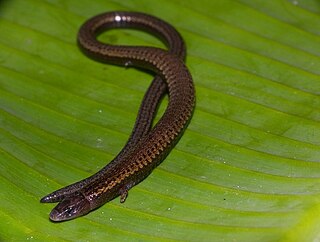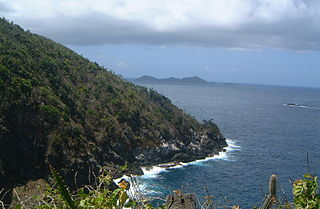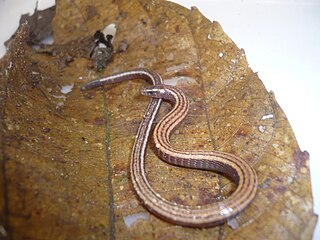
Bachia is a genus of lizards that belong to the spectacled lizards family.

Trinidad and Tobago are continental islands with a geologically very recent history of direct land bridge connection to South America. As a result, unlike most of the Caribbean Islands, Trinidad and Tobago supports a primarily South American flora and fauna and has greater diversity of plant and animal species than the Antilles. However, rates of endemism are lower than in the rest of the Caribbean because there has been less time for genetic isolation from mainland populations because of the history of land bridge connections and hence fewer opportunities for speciation, and so a greater proportion of the species in Trinidad and Tobago are also found on the South American mainland. Trinidad is nearer to mainland South America and has been directly connected to the mainland via land bridges more often and for longer periods than Tobago. This, as well as Trinidad's larger size and more varied topography and hydrology compared to that of Tobago allow greater species and ecosystem diversity on the former compared to that on the later of the islands.

Little Tobago is a small island off the northeastern coast of Tobago, and part of the Republic of Trinidad and Tobago.

Anolis trinitatis, also known as Saint Vincent bush anole, Saint Vincent's bush anole, or the Trinidad anole, is a species of anole lizard found in the Caribbean.
Bachia heteropa is a species of "microteiid" lizard in the family Gymnophthalmidae. The species is native to the Caribbean and northern South America. There are two recognized subspecies.
Bachia alleni is a species of lizard in the family Gymnophthalmidae. The species is endemic to the southern Caribbean.
Bachia barbouri, also known commonly as Barbour's bachia, is a species of lizard in the family Gymnophthalmidae. The species is endemic to Peru.

Bachia bicolor, the two-colored bachia, is a species of lizard in the family Gymnophthalmidae. It is found in Venezuela and Colombia.
Bachia bresslaui, also known commonly as Bresslau's bachia, is a species of lizard in the family Gymnophthalmidae. The species is native to southern South America.

Bachia dorbignyi, also known commonly as Dorbigny's bachia and lagarto-sem-pata in Brazilian Portuguese, is a species of lizard in the family Gymnophthalmidae. The species is native to central South America.

Bachia flavescens is a species of lizard in the family Gymnophthalmidae. It is found in Colombia, Venezuela, Guyana, Suriname, French Guiana, Tobago, and Brazil.
Bachia guianensis, the Guyana bachia, is a species of lizard in the family Gymnophthalmidae. It is found in Venezuela and Colombia.
Bachia intermedia, Noble's bachia, is a species of lizard in the family Gymnophthalmidae. It is endemic to Peru.
Bachia pallidiceps, Cope's bachia, is a species of lizard in the family Gymnophthalmidae. It is found in Costa Rica, Colombia, and Panama.
Bachia peruana, the Peru bachia, is a species of lizard in the family Gymnophthalmidae. It is found in Peru and Brazil.
Bachia pyburni is a species of lizard in the family Gymnophthalmidae. The species is endemic to South America.
Bachia scolecoides, Vanzolini's bachia, is a species of lizard in the family Gymnophthalmidae. It is endemic to Brazil.
Bachia talpa, Ruthven's bachia, is a species of lizard in the family Gymnophthalmidae. It is endemic to Colombia.
Bachia trisanale, also known commonly as Stacy's bachia, is a species of lizard in the family Gymnophthalmidae. The species is endemic to South America. There are three recognized subspecies.
Bachia whitei, White's bachia, is a species of lizard in the family Gymnophthalmidae. It is endemic to Tobago.







